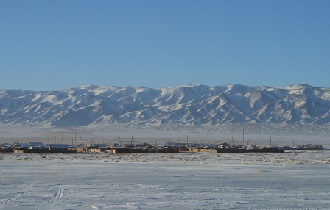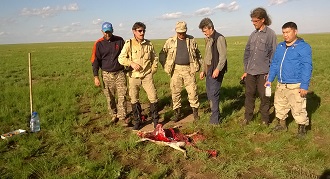
Saiga Mass Mortality: ongoing research on causes of mortality in saiga antelope in Kazakhstan and Mongolia
The saiga project is a long-term contribution from RVC to research into understanding of the causes of mortality of the saiga antelope. This species ranges in the Steppes of Asia, in a few localities but is classified as critically endangered by the International Union for Conservation of Nature (IUCN) red listing process due to a collapse of the population at the end of the 20th century from hunting and subsequent mass mortality events due to haemorrhagic septicaemia (HS) and peste des petits ruminants (PPR).

Challenge
The saiga antelope is a Pleistocene survivor of Central Asia and the keystone herbivore remaining on the vast open steppes. In recent decades, it appears the species has become vulnerable to disease related mass mortality, due to an opportunistic bacteria Pasteurella multocida in Kazakhstan. This disease in 2015 killed 88% of the main population of around a quarter of a million animals over three weeks. The long-term study by RVC and partners in Kazakhstan started in 2011 after a smaller die off in the Urals enabled this disease to be studied intensively.
The mass mortalities were found to be HS and closely associate with anomalous weather patterns and environmental conditions which may relate to climate change effects. PPR virus meanwhile has spread across Asia as a pandemic, reaching Kazakhstan in 2014 but due to warnings from the RVC Kazakh researchers on the possible vulnerability, the saiga did not suffer. Unfortunately, in Mongolia in 2016, the virus entered the country probably amongst livestock and despite mass vaccination spilled into wildlife species. This outbreak devastated the Mongolia subspecies of saiga causing 85% mortality of the only extant population in the plains east of the Altai mountains.
RVC was part of the joint FAO CMC crisis management team and has established another long-term relationship to study this disease under the framework of the PPR eradication and research programmes coordinated by the FAO/OIE.
Objectives of the Saiga project
1. Support Central Asia veterinary and wildlife authorities and NGOs in a HS and PPR disease research partnership, with other UK and European universities and institutions, to address objectives of the CMS Range State management of migratory species.
2. Provide professional wildlife health advice on a range of wildlife diseases emerging in the region including Lumpy Skin Disease affecting saiga.

Solution
Background mortality studies saiga
Annually a mission to monitor saiga calving events in Central Asia include RVC staff and students (other than COVID years) and they undertake routine clinical diagnosis and necropsy of dead and dying saiga during the spring. This includes supporting biological monitoring programmes by Frankfurt Zoological Society (FZS) and the Association Conservation of Biodiversity in Kazakhstan (ACBK).
Pathogenesis HS
An understanding of the pathogenesis of HS in saiga will help to elucidate the underlying causation of these remarkable mass mortality events and provide confirmation of risk factors and mechanism of bacterial invasion and sepsis. These likely opportunistic bacterial invasion events occur on a mass scale and synchronously across the population.
The precise mechanism for the change in bacterial activity associated with anomalous changes in temperature and humidity at the time of calving each year needs research. Latent infection has been confirmed but, as yet, the scale of latency is not determined and RVC pathology have set up an immunohistochemical method for confirming the presence of P multocida in tonsillar tissues collected annually from saiga that have died from natural causes like dystocia, which is relatively common in this species, that produces twins and triplets regularly.
If a high prevalence of latent bacteria is confirmed, from regular annual sampling of tissues, then the next stage will be to study the mechanism(s) for triggering bacterial activity and invasion of mucosal cells of the upper respiratory tract and epithelial cells of the gastrointestinal tract. The respiratory and intestinal invasion pathway evidence based on earlier histology of tissues in the HS caused mass mortality event of 2015.
Ongoing risk of PPR in wildlife in Central Asia
The RVC is part of the research team focusing on PPR in Mongolia and working closely with the PPR GREN and FAO secretariat, contributes to emergency outbreak response and evaluation of risks and vulnerabilities of Central Asia antelope to this viral pathogen through direct and supporting research with other partners such as Pirbright Institute in the UK.
The study locations
The field research on HS and background mortality undertaken in the Ural and Tengiz/Altyn Dala/Ural basin region of Kazakhstan. The study areas are ~ 500,000-kilometre square habitat used during calving of the two sub-populations. The area is characterised by steppe grassland with extreme summer and winter temperatures.
The PPR research is undertaken in region of Khovd Mongolia east of the Altai on desert plains.
Impact
The study findings to date provided unique information on the cause of mass mortality of saiga and the impact of PPR on saiga antelope.
The findings of Saiga research have been published in several papers. In addition, the team have presented at various UK and international meetings.
New findings have attracted global interest by media and science outlets as well as popular press and documentaries. More information on the impact of our study on "Our Impact".
Partners
We thank the UNEP CMS secretariat, various funders and supporters, including: UKRI NERC, FZS, NCEAS California, Morris Animal Foundation, FAO CMC, Fauna and Flora International, Saiga Conservation Alliance, Wildlife Conservation Society. Research partners include: FAO PPR GEP and GREN; Pirbright Institute UK; FLI Berlin; Queens’ University, Belfast; Swedish Agricultural University, Sweden; University of Calgary, Canada; and Kazakh Veterinary Authorities, Ministry of Environment Forestry and Hunting, Biosafety Institute Gvardeskiy and ACBK/FZS/FFI conservation partnership.
Publications
In the Media
| Media (with link if available) | Type |
| Lovenature.com | Article |
| CNN | Article |
| Express.kz | Article |
| Kazakh gvt | Article |
| IISD | Article |
| PHYS.org | Article |
| Aljazeera_1 | Article |
| Aljazeera_2 | Article |
| Houston Chronicle | Article |
| International Business Times | Article |
| IFL Science | Article |
| Notre planete | Article |
| New York Times | Article |
| Oxford Biology Alumnus Newsletter | Article |
| Royal Veterinary College | Article |
| Saiga Conservation Alliance_1 | Article |
| Saiga Conservation Alliance_2 | Article |
| Saiga Conservation Alliance_3 | Article |
| Saiga Conservation Alliance_4 | Article |
| Saiga Conservation Alliance_5 | Article |
| Saiga Conservation Alliance_6 | Article |
| Business Insider UK_1 | Article |
| Business Insider UK_2 | Article |
| Frankfurt Zoological Society | Article |
| Mongabay | Article |
| The Guardian_1 | Article |
| The Guardian_2 | Article |
| DW_1 | Article & clip |
| DW_2 | Clip |
| DW_3 | Clip |
| DW_4 | Clip |
| DW_5 | Clip |
| Aljazeera_3 | Clip |
